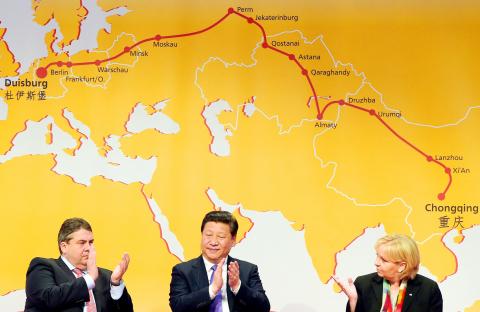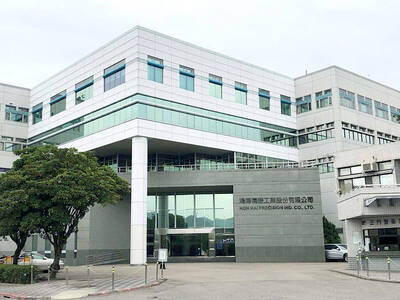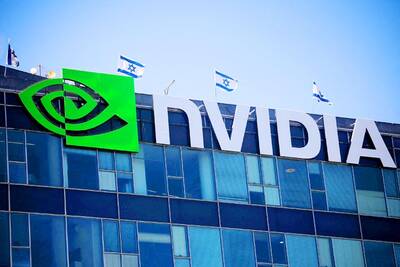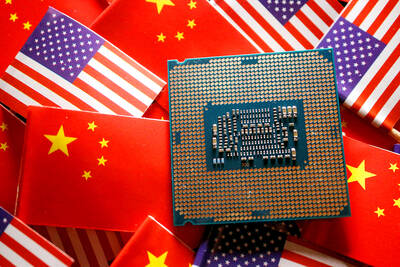One of the world’s longest railways — a “modern-day silk road” — covers about 11,000km en route from the Chinese megacity of Chongqing to Duisburg, a key commercial hub in western Germany.
On Saturday, as part of his landmark visit to Germany, Chinese President Xi Jinping (習近平) visited the last stop on the “Yuxinou” (渝新歐) rail line, an industrial feat that promises to revolutionize transport between Europe and Asia.
Duisburg is a steelmaking town of about half a million on the confluence of the Rhine and Ruhr rivers that boasts the world’s biggest inland port and is one of Germany’s most important transport and commercial hubs.

Photo: AFP
Despite the vast distances between them, it takes just 16 days for trains to travel to Duisburg from Chongqing, a sprawling metropolitan symbol of rising China with a population of more than 30 million.
Xi, accompanied by a large Chinese delegation and German Federal Minister of Economics and Energy and Vice Chancellor Sigmar Gabriel, ceremoniously welcomed a freight train crammed with laptops and electronics after it completed its journey through Central Asia, Russia, Belarus and Poland.
Set up in 2011 by a group of rail companies, the Yuxinou is just 2,000km short of the world’s longest rail line that links Germany to Shanghai. It has shaved more than 20 days off the sea route.
The route is particularly useful for Chongqing — home to vast car parts and IT factories — since it lies 1,500km from China’s main seaports.
“The value of this rail link, known in China as the ‘new silk road,’ is more than just symbolic,” German Port of Duisburg spokesman Julian Boecker told reporters.
“It has found itself a position in the market and now operates up to three weekly services,” he said.
Yet one of the biggest challenges will be to boost traffic in both directions to make it more profitable. It is not uncommon for the Yuxinou trains, which can transport as many as 50 containers, to be full when they arrive in Duisburg, but empty when they return to China.
“At the moment, the amount of goods traveling from China to Europe is much larger than the other way round. That’s a problem,” market research group SCI Verkehr director Maria Leenen said.
It was sea transport that gradually supplanted the historic Silk Road trade route linking Asia with Europe centuries ago.
Sea transport still accounts for more than 95 percent of goods trading between the two regions, said Burkhard Lemper of the logistics consultants ISL.
Rail’s share of the market remains tiny, and for now, the Yuxinou link only complements existing transport systems.
Yet “rail is twice as fast as sea transport and twice as cheap as air freight,” said Erich Staake, head of the company that operates the Port of Duisburg.
For Leenen, “both sides benefit” from the link.
“Europe can meet a sudden surge in demand in industry or trade, say in textiles, while China can reach its markets more rapidly,” she said.
The link provides a welcome transport connection and gateway for Chinese provinces situated deep inside the country.
“It’s still early days yet for this mode of transport, but it could have a promising future if the conditions are right, notably in terms of safety and security, punctuality and a stable political situation,” Leenen said.
Other electronics companies, such as Foxconn (富士康) of Taiwan which supplies Apple Inc, or computer giant Acer (宏碁), as well as car parts suppliers and machine-tool makers, all have factories in Chongqing.
The Port of Duisburg hopes that the importance of the rail link will increase after Xi’s visit.
“We’re in negotiations with companies, such as automakers, on a possible expansion of the service,” Boecker said.
“There are people who aren’t aware that it even exists,” he said. “We hope to increase customers in both directions.”
China is Germany’s top trade partner in Asia, while Germany is China’s leading European partner. Bilateral trade exceeded US$161.5 billion last year.

Shares in Taiwan closed at a new high yesterday, the first trading day of the new year, as contract chipmaker Taiwan Semiconductor Manufacturing Co (TSMC, 台積電) continued to break records amid an artificial intelligence (AI) boom, dealers said. The TAIEX closed up 386.21 points, or 1.33 percent, at 29,349.81, with turnover totaling NT$648.844 billion (US$20.65 billion). “Judging from a stronger Taiwan dollar against the US dollar, I think foreign institutional investors returned from the holidays and brought funds into the local market,” Concord Securities Co (康和證券) analyst Kerry Huang (黃志祺) said. “Foreign investors just rebuilt their positions with TSMC as their top target,

REVENUE PERFORMANCE: Cloud and network products, and electronic components saw strong increases, while smart consumer electronics and computing products fell Hon Hai Precision Industry Co (鴻海精密) yesterday posted 26.51 percent quarterly growth in revenue for last quarter to NT$2.6 trillion (US$82.44 billion), the strongest on record for the period and above expectations, but the company forecast a slight revenue dip this quarter due to seasonal factors. On an annual basis, revenue last quarter grew 22.07 percent, the company said. Analysts on average estimated about NT$2.4 trillion increase. Hon Hai, which assembles servers for Nvidia Corp and iPhones for Apple Inc, is expanding its capacity in the US, adding artificial intelligence (AI) server production in Wisconsin and Texas, where it operates established campuses. This

H200 CHIPS: A source said that Nvidia has asked the Taiwanese company to begin production of additional chips and work is expected to start in the second quarter Nvidia Corp is scrambling to meet demand for its H200 artificial intelligence (AI) chips from Chinese technology companies and has approached contract manufacturer Taiwan Semiconductor Manufacturing Co (TSMC, 台積電) to ramp up production, sources said. Chinese technology companies have placed orders for more than 2 million H200 chips for this year, while Nvidia holds just 700,000 units in stock, two of the people said. The exact additional volume Nvidia intends to order from TSMC remains unclear, they said. A third source said that Nvidia has asked TSMC to begin production of the additional chips and work is expected to start in the second

US President Donald Trump on Friday blocked US photonics firm HieFo Corp’s US$3 million acquisition of assets in New Jersey-based aerospace and defense specialist Emcore Corp, citing national security and China-related concerns. In an order released by the White House, Trump said HieFo was “controlled by a citizen of the People’s Republic of China” and that its 2024 acquisition of Emcore’s businesses led the US president to believe that it might “take action that threatens to impair the national security of the United States.” The order did not name the person or detail Trump’s concerns. “The Transaction is hereby prohibited,”